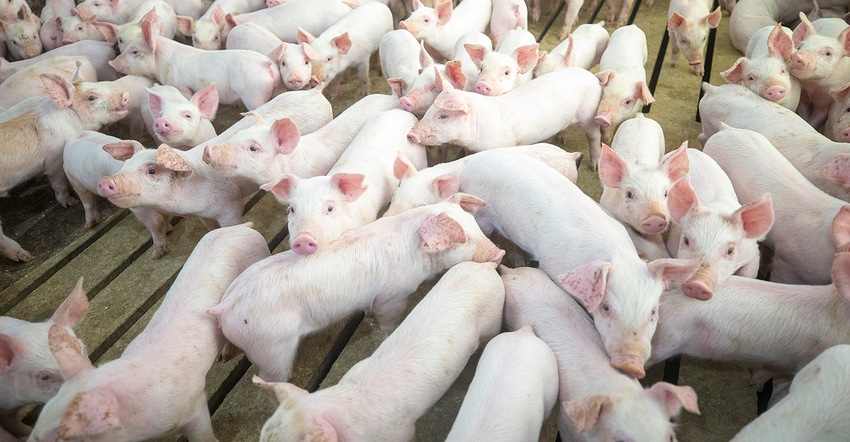Research results highlight the importance of implementing vaccination programs at the system level rather than site-specific interventions.
January 14, 2020

Lawsonia intracellularis is an intracellular bacterium and causative agent of proliferative enteropathy (ileitis) in pigs as well as a variety of other species. Antimicrobials have been widely used to control and reduce the economic losses due to PE. The recent changes on regulation for the use of antimicrobials as growth promoters will directly impact well-established strategies used to control PE and other enteric diseases.
This scenario has driven implementation of vaccination strategies especially for controlling bacterial endemic diseases that were previously well manageable with the use of antimicrobials. Although studies have been focused on the individual efficacy of vaccines toward the reduction of clinical signs, the impact of vaccination on transmission rates and probability of infection in naïve and vaccinated animals have proven to have great value in driving important decisions about control of swine diseases, such as influenza and Mycoplasma hyopneumoniae (Romagosa et al 2011 and Roos et al 2016).
Our objective was to study the spreading of L. intracellularis infection in naïve and vaccinated pigs by assessing the impact of vaccination on transmission rate and fecal shedding.
Experimental design
A seeder-pig sentinel model was used (Figure 1). Ninety pigs were divided into three groups: orally vaccinated (Enterisol Ileitis); intramuscularly vaccinated (Porcilis Ileitis) and non-vaccinated. Day 21 post-vaccination, nine seeder pigs were challenged with L. intracellularis. Day 7 post-inoculation, seeder pigs were commingled as described in Figure 1.

Transmission rate and expected probabilities of shedding were assessed with the susceptible-infectious model. Animals were considered infectious when fecal quantitative polymerase chain reaction was equal or more than 103 L. intracellularis per gram of feces (Collins et al, 2001).
In practical terms, this would roughly represent a threshold cycle of 31 or less based on the PCR assay offered by the University of Minnesota Veterinary Diagnostic Laboratory.
Results and practical implications
Vaccination against L. intracellularis has been applied over the years with successful reduction of the clinical signs and fecal shedding, and resulting in significant improvement of growth performance in vaccinated animals.
The assessment of the transmission rate under a non-vaccinated scenario showed that one infectious pig (shedding more than 103 bacteria per gram of feces) is able to transmit L. intracellularis to three susceptible pigs per week.
From a practical standpoint, if pigs from infected and naïve flows are commingled at 10 weeks of age (end of the nursery phase) the number of infected pigs triplicate within the population every week.
The results revealed that the chronic nature of the Lawsonia infection at the individual level is also reflected in the transmission of the disease at the population level characterizing a prolonged spreading of the infection in the finishing barn.
Although the Lawsonia infection can impact the productive performance in the first weeks of the finishing phase when naïve pigs just started getting infected, the clinical diagnosis is only evident when most of the naïve population is infected and some animals are exhibiting diarrhea. This typical clinical scenario is usually observed only at later stages of the finishing phase when the animals are approaching the marketing age and it can misrepresent the actual impact of the disease in terms of performance throughout the growing-finishing phase.
In the present study, transmission rates were significantly reduced in both vaccinated groups: 1.8 infected pig per week in the orally-vaccinated and 1.7 infected pig per week in the intramuscularly-vaccinated group.
The model used to predict transmission over time also showed decreasing in the period of fecal shedding of Lawsonia in both vaccinated groups. While the median period of shedding in non-vaccinated animals was 11.2 weeks, orally- and intramuscularly-vaccinated animals showed 6.3 and 8.3 weeks, respectively.
These results highlight the importance of implementing vaccination programs at system level rather than site-specific interventions. This strategy prevents the risk of commingling batches of pigs from vaccinated and non-vaccinated sources, therefore reducing the impact of the disease in downstream flows.
References
Collins, A.M., Dijk, M.V., Vu, N.Q., Pozo, J., Love, R.J. 2001. Immunity to Lawsonia intracellularis. In: Proceedings of the Allen D. Leman Conference, 28, Minneapolis, p.115-120.
Velthuis AG, De Jong MC, Kamp EM, Stockhofe N, Verheijden JH. Design and analysis of an Actinobacillus pleuropneumoniae transmission experiment. Prev Vet Med. 2003 Jul 30;60(1):53-68.
Romagosa A, Allerson M, Gramer M, Joo HS, Deen J, Detmer S, Torremorell M. Vaccination of influenza A virus decreases transmission rates in pigs. Vet Res. 2011 Dec 20;42:120.
Roos LR, Fano E, Homwong N, Payne B, Pieters M. A model to investigate the optimal seeder-to-naïve ratio for successful natural Mycoplasma hyopneumoniae gilt exposure prior to entering the breeding herd. Vet Microbiol. 2016 Feb 29;184:51-8.
Acknowledgement: This study was funded by the National Pork Board.
Sources: Erika Vasquez, Robert Valeris, Dana Beckler and Fabio Vannucci, who are solely responsible for the information provided, and wholly own the information. Informa Business Media and all its subsidiaries are not responsible for any of the content contained in this information asset.
You May Also Like



